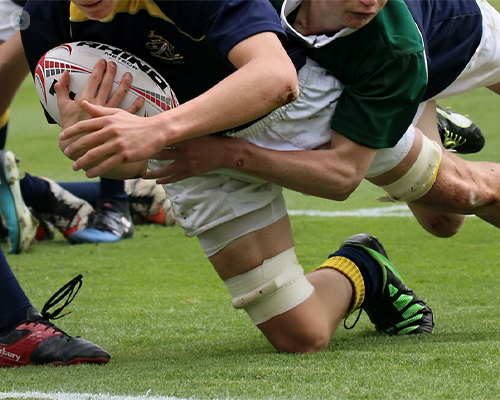Taking care in the Olympics: rugby and sporting knee injuries II
Autore:Following his first article describing the types of knee injuries that may occur in rugby 7s and other high-impact professional sports, consultant orthopaedic and traumatology surgeon Mr Andrew Edwards continues in this next part to tell us the course of treatment for knee injuries that happen in sports.

What are the signs that a player should receive treatment?
The precise mechanism of injury can be multitude. However, the principals of forceful forward shift of the tibia (shin bone) from the femur (sagittal plane force), and the combined twisting movement, inward knee force and initial knee flexion (valgus/rotation force) are most commonly seen. For example, the tackling player contacts with shoulders and upper body at the level of the hips or below whilst the ball carrier is trying to pivot or sidestep out of the way. Another example is where a player jumps for the ball and lands awkwardly, hyperextending their knee or pivots on landing. If you have ever experienced an ACL rupture, you probably know the experience of a player who immediately knows something bad has happened, has the sense of “doom”, hears the sound of a “pop”, is in pain almost immediately, and their knee swells up almost straight away and they cannot continue to play. If a sports person has a knee injury that results in bleeding into their knee within the first hour or so, is very likely to be a serious injury. This could be an ACL rupture, a large meniscus tear, or a fracture of the cartilage surface and bone. They need investigation as soon as able, most often with an MRI scan.
How are sports knee injuries treated?
The treatment of knee injuries in rugby players and those in high-impact sport depends on the nature of the injury and the expectation of the athlete. Although ACL injuries can be treated by rehabilitation alone, it is not likely that the athlete will be able to return to their level of sport. Therefore, it is more often the case that ACL reconstruction surgery is needed. Similarly, if the athlete has a grade 3 MCL injury (complete detachment of the MCL from the tibia or the femur), they usually require repair surgery. Meniscus tears can be small and settle without surgery or with arthroscopic trimming, or can be peripheral or severe and require surgery to repair (or even replace).
How long do knee sports injuries take to recover from and how can they be managed at home?
Whatever injury the player has sustained to their knee, the road to recovery will be via careful and progressive rehabilitation programmes. Recovery needs to be in phases (typically four) and the athlete must not progress to the next phase until they have achieved the goals of the phase they are in. In simple terms, phase one is to protect the knee from further injury or to protect the post-surgery repair whilst reducing the swelling, achieving early range of movement, and controlling pain. Phase two is to gain control and early strength of the knee and leg, learning to walk correctly without limping, and regain position sense and balance. Phase three is where the athlete increases their ability and strength to 80 to 90 per cent of the uninjured side, and phase four is a graduated return to sport with specific drills and exercises appropriate to their sport. Typically, for an ACL injury these phases last six weeks for phase one and two, three months for phase three, and three to six months for phase four. In rugby 7s, due to the explosive nature of the sport, it often takes a full 12 months of rehabilitation before the player is ready for selection to play.
If you are an amateur athlete, the one of the most important steps is to have a clear diagnosis made by an appropriate doctor or physiotherapist. If surgery is required, your doctor will have given instructions on the first phase of recovery and you should have early physiotherapy appointments. It is not always possible to be treated by a physiotherapist or sports therapist three or four times a week. Therefore, it is important you dedicate time to home rehabilitation. Control the early phases of injury with the first aid measures of pain control, rest, ice, compression, and elevation (PRICE). Gentle range of movement exercises and muscle contraction exercises will be useful. There are a number of rehabilitation programmes found on the internet, most of which are perfectly adequate to help your recovery, but it is still important to find time to visit a physiotherapist to help guide you through the recovery programme and assess your progress.
My practice involves professional and amateur rugby players, both union and league, as well as many other sports. I find it helps to give a realistic expectation of recovery to the athlete and a reasonable indication of the length of recovery to expect. The best results are when the surgery is expertly undertaken and the rehabilitation is directed by top notch physiotherapists and trainers. However, the dedication of the athlete to their own recovery is the most important factor in getting the best outcome possible.
If you have a knee injury from rugby or any other activity, or would like more information, you can go to Mr Edwards's profile and book a consultation.


